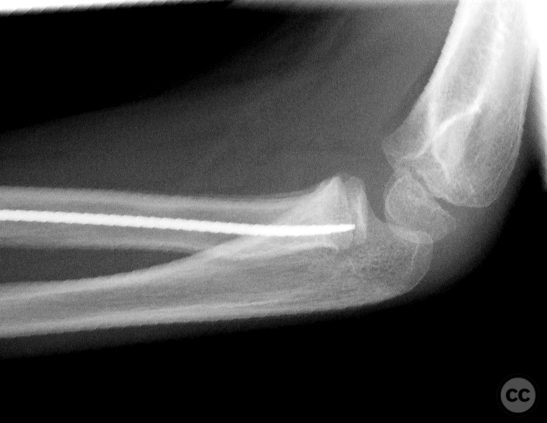Metaizeau technique radial neck fracture
Score and Comment on this Case
Clinical Details
Clinical and radiological findings: Metaizeau reduction using an ECMES Ti wire
Preoperative Plan
Planning remarks: In light of recent literature, the Métaizeau technique has established itself as an effective, minimally invasive surgical intervention for paediatric radial neck fractures. Judet classification forms a foundation for therapeutic decision-making with type III-IV fractures demonstrating a clear surgical indication for this method. The operative plan commences with the reduction under fluoroscopy control, ensuring a thorough evaluation of the alignment and rotation of the fracture fragments. A closed reduction and internal fixation with elastic intramedullary nailing is then implemented, which forms the crux of the Métaizeau technique. This step necessitates the insertion of the nail in a retrograde fashion, and is dependant on the stability of the elbow joint to hold the radial head in position during insertion. In order to augment stability, a surgical tip would be to incorporate percutaneous K-wire fixation in conjunction with the Métaizeau technique. The results of this method are corroborated by a retrospective analysis of 21 patients who demonstrated favourable outcomes. In comparison to alternative methods such as percutaneous joystick reduction with Kirschner wires and open reduction with or without internal fixation, the Métaizeau technique has consistently yielded superior results. The evidence-based therapy recommendation for a Judet type IV PRNF is, therefore, the Métaizeau technique, supplemented with percutaneous K-wire fixation for enhanced stability as required. This recommendation is supported by a number of studies, advocating its efficacy and outcomes, particularly in maintaining the integrity of soft tissue.
Surgical Discussion
Operative remarks:coming
Search for Related Literature

Dr Ed Oates
- Germany , Schleswig Holstein
- Area of Specialty - General Trauma
- Position - Specialist Consultant

Industry Sponsership
contact us for advertising opportunities








Article viewed 1221 times
12 May 2023
Add to Bookmarks
Full Citation
Cite this article:
Oates, E.J. (2023). Metaizeau technique radial neck fracture. Journal of Orthopaedic Surgery and Traumatology. Case Report 27152306 Published Online May 12 2023.